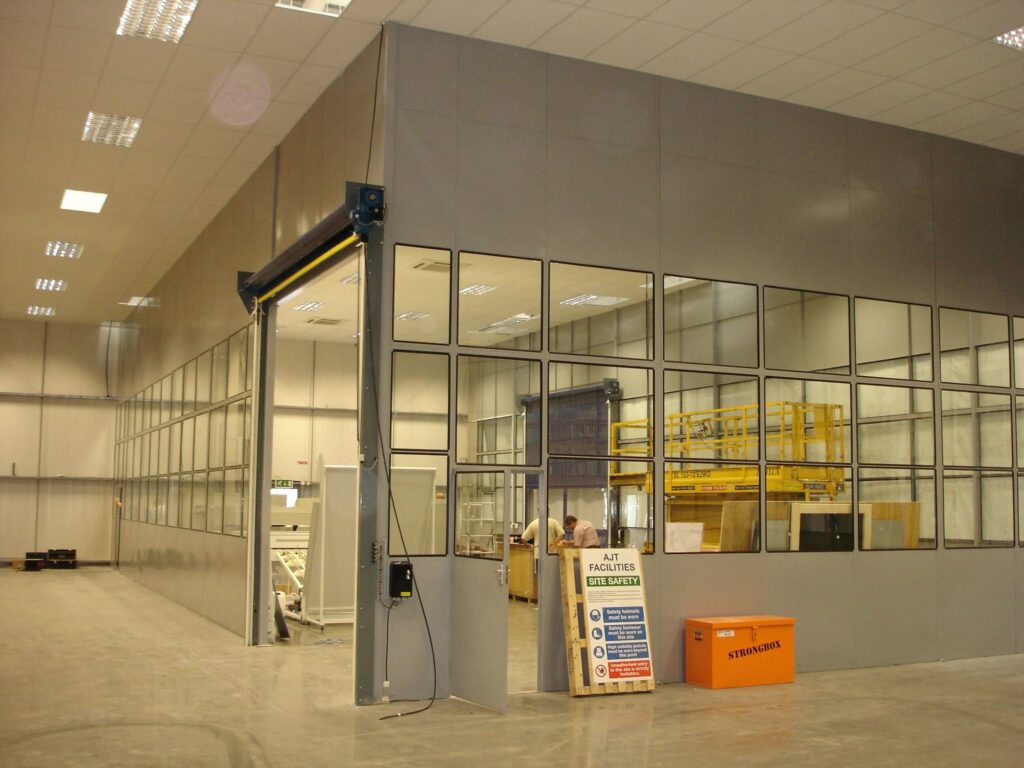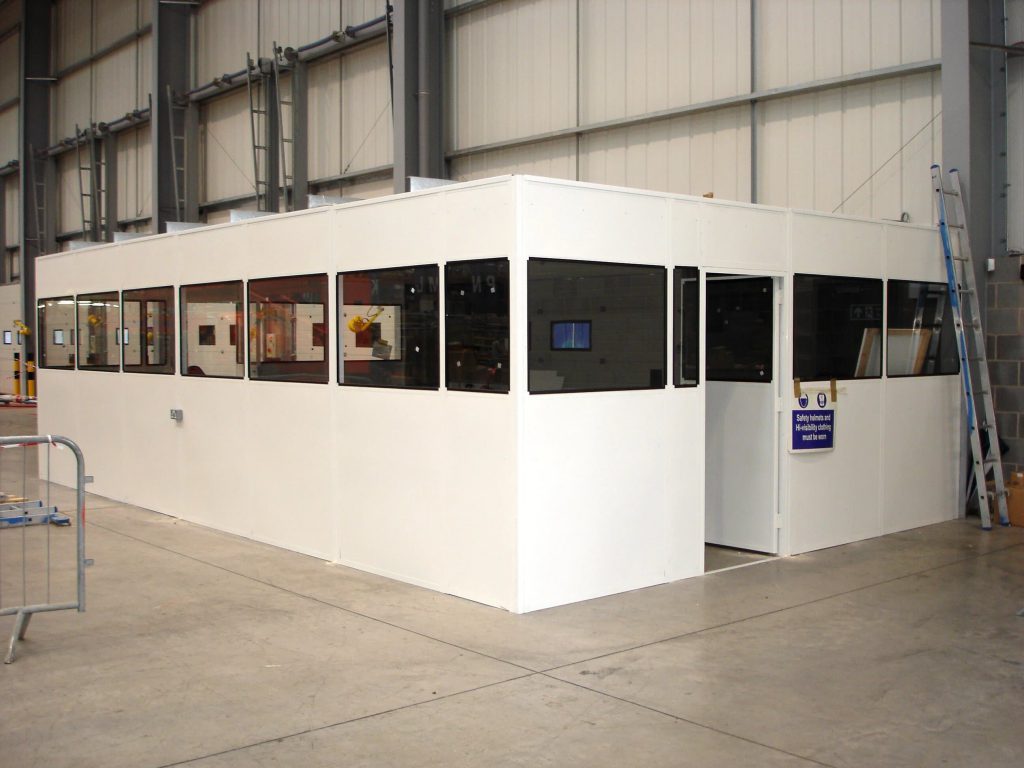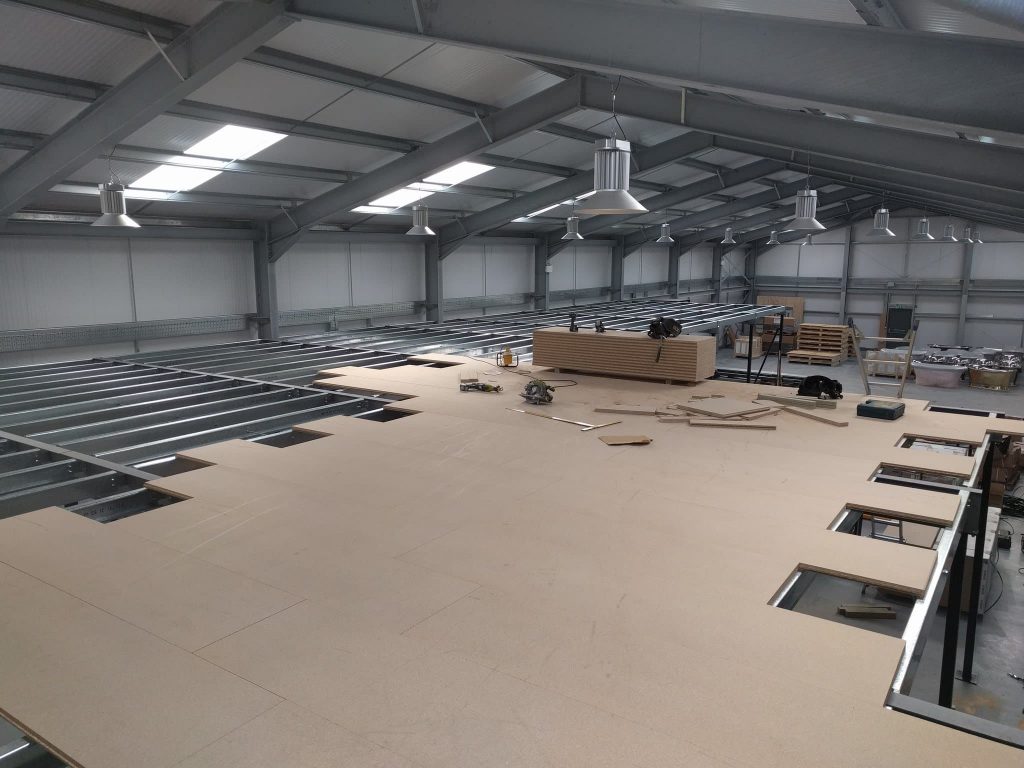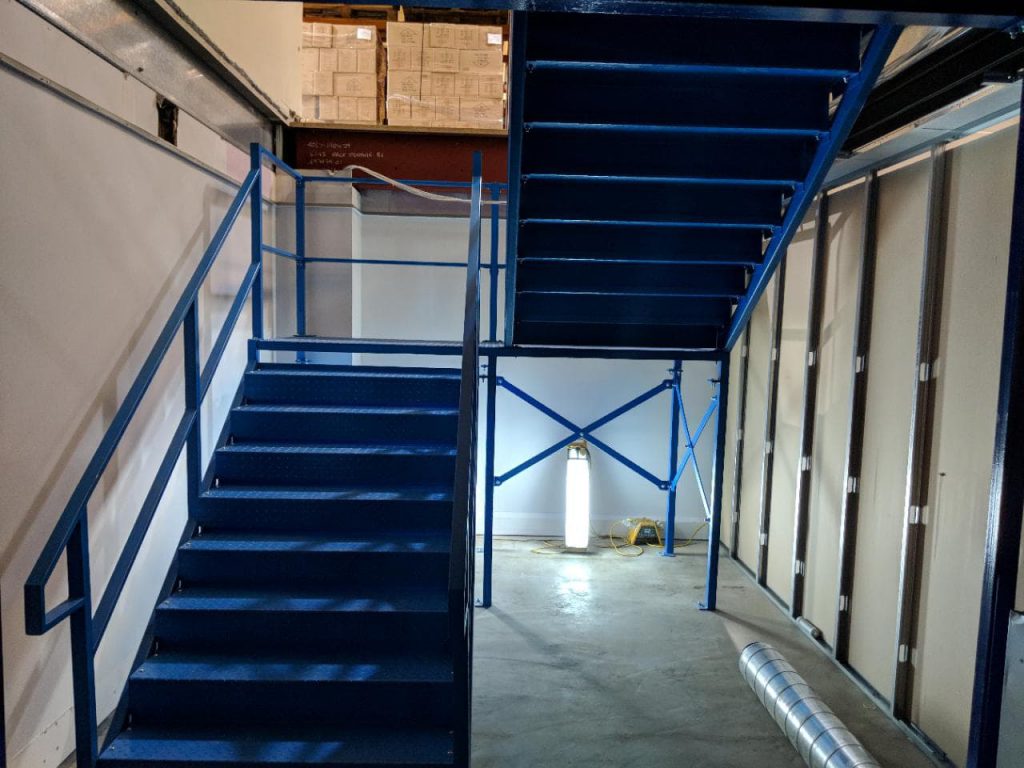Our cages offer many advantages in a warehouse or industrial setting. But which type should you choose? There are several different storage cage options for warehouses and stockrooms, and the best product will depend on the layout of your space, the products you are storing and any special requirements you have, such as the flexibility to reconfigure your storage space or a need for high security.
Secure Metal Cage Storage, for Valuable Stock
This cage storage option provides a secure environment for your stock. Durable, metal security cages are designed to protect high-value or sensitive items. They often come with locking mechanisms and are used to secure items like high-value products, expensive tools, or confidential documents. The enclosed structure can be fitted with various lock options, and mesh sizes to deter potential thieves.
Modular Cage Storage, for Flexible Configuration
Modular storage cages are built using standardised components that can be easily assembled and disassembled. The modular design allows for quick adjustments and reconfigurations without the need for extensive construction or modifications. You can configure the cages to match the size and shape of your available space and adapt them to accommodate different types of products or items with varying dimensions. As your storage needs evolve, modular storage cages can be adjusted accordingly.
Outdoor Cage Storage, for Weather-Resistant Durability
Outdoor cage storage is well-suited for storing large or bulky items that may not easily fit within indoor storage facilities. This may include items like construction materials, heavy machinery, oversized equipment or landscaping supplies. It can also act as overflow storage, with outdoor modular security cages offering the flexibility you need to expand outdoors when required. While not as secure as indoor storage, outdoor cage storage can shield items from rain, snow, and sunlight, reducing the risk of weather-related damage.
Wire Mesh Cage Storage, Visibility and Ventilation
Wire mesh cages are versatile and commonly used for storing a wide range of items, from small parts to larger products. They allow for good visibility of the contents, and proper ventilation.
Wire mesh partitioning allows for visibility of the contents within an enclosed area. This is valuable for inventory management, equipment monitoring, and visual inspection of stored items without the need to open or enter the partition. Unlike solid walls, wire mesh partitions provide good airflow and ventilation while maintaining a physical barrier. This can be essential in areas where temperature regulation or air quality control is important.
So Which Cage Storage Solution Should You Choose?
If you’re still not sure which type of storage cage is right for your needs, the experts at Rack Storage will be happy to help. You can download our storage cage brochures to find out more about the products we offer or contact us with any questions you may have. With over 35 years of experience in warehouse storage solutions, we are well-placed to help you find the right product for your individual needs.
Not Sure What You’re Looking For?
Who We Work With
Mezzanine floors offer valuable additional space for storage, offices, or production areas within a warehouse or industrial facility. However, ensuring the safety of personnel and the protection of goods on these elevated platforms is an absolute priority. That’s where mezzanine pallet gates are so vital. In this blog, we will explore the function of mezzanine pallet gates and how they provide essential edge protection for mezzanine floors, keeping both workers and stored items safe.
Understanding Mezzanine Pallet Gates
Mezzanine pallet gates, also known as mezzanine gates or mezzanine safety gates, are specialised barriers designed to prevent falls from the edges of mezzanine floors while allowing easy and efficient movement of goods using forklifts, pallet jacks, or other material handling equipment. These gates provide a secure access point when loading or unloading materials onto the elevated platform.
Function and Benefits
Enhanced Safety
Mezzanine pallet gates act as physical barriers that prevent accidental falls from mezzanine floors, reducing the risk of injuries and ensuring the safety of workers. By providing a controlled access point, these pallet safety gates help to create a secure working environment.
Versatile Design
Mezzanine gates are available in various configurations to suit different requirements. Swing gates, sliding gates, and pivot gates are among the commonly used designs. Each type offers unique benefits, such as maximising floor space, accommodating large loads, or facilitating one-way traffic flow.
Efficient Material Handling
Mezzanine pallet gates enable seamless movement of goods between the mezzanine floor and ground level. They allow forklifts or pallet jacks to safely load or unload pallets, reducing the time and effort required for manual handling. This streamlined process also contributes to increased productivity.
Mezzanine Pallet Gate Features
Dual-Gate System: Mezzanine gates typically employ a dual-gate system, ensuring that one gate is always in the closed position while the other is open. This configuration provides a secure barrier at all times, eliminating the possibility of an unprotected edge.
Counterbalanced Design: Mezzanine gates are designed with counterweights or springs, allowing for smooth and effortless operation. These mechanisms ensure that gates automatically return to their closed position after use, maintaining edge protection at all times when not in use.
Safety Regulations and Compliance
To maintain workplace safety, it is crucial to adhere to relevant safety regulations and guidelines. Here are some key considerations when implementing mezzanine pallet gates:
Regulatory Standards
Different countries have specific safety regulations and standards for mezzanine floors and edge protection. It is essential to consult local regulations, such as those provided by the HSE (Health and Safety Executive) in the UK, to ensure compliance.
Load Capacity
Mezzanine gates should be designed and installed to withstand the intended loads and forces. Manufacturers provide load capacity ratings for their gate systems, so it is important to consider these specifications when selecting and installing your new gates.
Regular Inspections and Maintenance
Periodic inspections and maintenance routines are essential to ensure the continued effectiveness and safe operation of mezzanine pallet gates. Regularly checking gate mechanisms, hinges, latches, and overall structural integrity is necessary to identify and address any potential issues as quickly as possible.
Mezzanine pallet gates play a vital role in providing edge protection and ensuring the safety of workers and goods on mezzanine floors. By combining enhanced safety features with efficient material handling, these gates contribute to a secure and productive working environment. Adhering to safety regulations and conducting regular inspections will help maintain the effectiveness and reliability of mezzanine gates, ensuring the ongoing safety of everyone involved.
If you would like to find out more about our Mezzanine flooring, and how we keep warehouse teams safe please contact us or get a quote today.
Not Sure What You’re Looking For?
Who We Work With
Having a warehouse that uses available space efficiently is vital for maximising productivity and growing your business. When planning your warehouse space management, small changes can help you to save on rent by storing more in the space you have.
If you are a warehouse owner or manager seeking to enhance your warehouse space and increase profit, read on for the 5 top tips from Rack Storage Solutions.
1. Calculate your warehouse space utilisation
Getting clear on how much space you use when warehouse capacity planning can help identify inefficiencies. From here you can create a logical sequence that boosts productivity and determine the next steps.
- Start by multiplying the square footage of usable storage space (disregarding office space, toilets and non-usable space) by the height of your warehouse to work out your total warehouse space size.
- To work out your actual storage cube size, multiply the total capacity of each rack by total number. This is your storage capacity, based on your current setup.
- Divide your current storage capacity by your total warehouse size in cubic feet and multiply by 100. The number you get is your potential storage area. Between 22-27% is optimal so there is room for picking, loading and unloading efficiently; lower than 22% means improvements could be made.
2. Reduce aisle width when warehouse capacity planning
If you have identified that your storage area isn’t being utilised to its full capacity, an easy step to boost warehouse storage space is to reduce aisle width.
Decreasing aisle width to between 5-8 feet within the racking area can save up to 20% on space. Calculate how much space is needed for forklifts and compare this to your current aisle space. However, consider the expense of wire guidance in a very narrow
aisle situation.
3. Increase vertical storage in your warehouse space
An easy way to increase your warehouse storage capacity is through using the vertical space. Using your calculations, look at your warehouse height and analyse how well your racking system is working. Can any lower-selling inventory be moved higher to free up space for best-sellers?
Check to see if a new warehouse storage system may be more efficient, keeping in mind how the business might develop in the future. Or can you add to your current system?
Consulting a structural engineer can help prevent any pitfalls of base plates or racking uprights being the wrong size.
Adding mezzanine flooring and walkways can maximise inventory storage, particularly in warehouse spaces where picking and order preparation tasks are involved. Make sure you comply with building safety regulations.
4. Place your beams strategically
When looking at your warehouse space management, make sure your beam heights are working optimally for you. Sometimes when products are reassigned to different places, the container is no longer an ideal fit.
Resetting your beam heights to allow for only the minimum required space between the product and bottom of the rack beam can create extra storage capacity.
If you have a lot of extra space, additional beam levels can transform your warehouse capacity.
5. Reduce congestion at inbound and outbound areas
Warehouse capacity planning isn’t just about increasing storage size. Warehouse managers and business owners know the areas where incoming products are delivered and picked goods are loaded are critical to the smooth running of operations. These spaces have high footfalls and equipment, which can be chaotic.
Rather than making these areas as small as possible, a smart way that saves time and avoids costly delays is to resize to improve the flow of goods and people. Making them run more smoothly can increase yields from your warehouse space.
Make the most of your capacity, with Rack Storage
Optimising your warehouse capacity when planning is essential to increasing productivity without the need for expansion. By getting clear on your current storage capacity, reducing aisle width, increasing vertical storage, placing your beams optimally and decreasing congestion in critical areas, you can use your space fully to improve your bottom line.
There is no one size fits all solution for warehouse space management. At Rack Storage, we’re experts at warehouse storage solutions to get the best out of your unique space.
Contact us on 01707 394 847 or email sales@rackstorage.co.uk today.
Not Sure What You’re Looking For?
Who We Work With
If you use pallet racking in your warehouse, you need to be aware of the health and safety regulations that are subject to inspection. Our complete racking inspections guide will take you through everything you need to know to keep your warehouse safe and pass your pallet racking safety inspection.
What does the law say about racking inspections?
Warehouse racking regulations include the following:
The 1998 Law – Provision and Use of Work Equipment Regulations (PUWER) states that all racking equipment comes under the legislation of heavy work equipment which, “must be inspected and maintained on a regular basis”.
In 2015, the Health and Safety Executive (HSE) Construction, Design and Management Regulations, made it a legal responsibility for warehouse owners to ensure that safety regulations are met and that all workers within a warehouse are competent.
HSE Pallet Racking Regulation Document
If you are feeling overwhelmed about how to keep your warehouse safe and legal, the HSE provide guideline booklets for each safety regulation. The HSG76 Warehouse and storage: A guide to health and safety booklet contains the safety information that specifically relates to pallet racking safety in a warehouse.
Every warehouse manager should familiarise themselves with the HSE guidelines.
What happens during a warehouse racking inspection?
Racking inspections should be carried out by a qualified SARI (SEMA-Approved Racking Inspector) or a Technically Competent Person at least once a year.
The steps taken during a warehouse safety inspection are:
- The SEMA inspector will carry out a visual inspection from the warehouse floor.
- The inspector will ask to see evidence of health and safety documentation such as daily/weekly checks carried out by the designated person in charge of racking safety in your warehouse.
- A full warehouse inspection report with analysis of any damage or concerns will be sent after the inspection is complete.
How to pass a pallet racking inspection
Pallet racking is a safe and versatile warehouse storage choice but make sure you only purchase racking equipment from trusted professionals. Trained specialists, such as the experts at Rack Storage Systems, can guide you in the planning, installation, and maintenance of your warehouse storage system.
When your pallet racking is being installed or maintained, make sure that important safety considerations are followed, such as how racking is secured to the floor. It is the legal responsibility of the warehouse owner to check the credentials of any contractor or worker within their warehouse.
Appoint a designated rack safety person in your warehouse who carries out regular internal inspections based on the HSE pallet racking safety guidelines. All staff should be trained on how to report safety concerns or damage.
If your whole team is aware of warehouse health and safety regulations and you carry out regular internal warehouse inspections, you should have no problem passing your pallet racking safety inspection.
High-quality pallet racking from Rack Storage
At Rack Storage, our pallet racking systems are manufactured to a standard you can trust. Discover our high-quality new and used pallet racking systems for your warehouse and get a quote today.
Not Sure What You’re Looking For?
Who We Work With
Why sell your pallet racking?
The most common reasons for selling pallet racking are relocation, updating or developing current structures, warehouse closure or simply for profit. No matter the reason, everyone wants the best return when selling on their pallet racking, so it’s important to know how best to sell unwanted warehouse storage equipment. Here’s an insight into helping you understand how much your pallet racking is worth.
What do we look for when buying pallet racking?
Rack Storage are experts in the field of warehouse storage equipment. As major buyers of all pallet racking, shelving systems and mezzanine floors, we have a unique insight into the market and expected values.
Good quality, well-looked-after equipment can always find a new home. Here at Rack, we are always on the lookout for well-maintained used racking and shelving.
How to maximise the value of your pallet racking
The key to the best return when selling your pallet racking is looking after it well. Racking systems should be thoroughly inspected before being dismantled carefully and stored appropriately in preparation for sale. During any transportation, the pallet racking should be stored securely to ensure it remains in the best condition during transit.
Our experienced team can advise on how to look after your pallet racking to maximise its value. If you choose to sell your unwanted storage equipment to Rack Storage, you can trust in our qualified dismantling team to make the entire process easy and stress-free.
Tips on how to start selling your pallet racking
The first step to take when considering selling your pallet racking is to contact a trusted and experienced buyer, such as Rack, for a full appraisal of your warehouse system.
Pallet racking pricing is dependent on several factors such as the original cost, the product manufacturer and quality of steel. The structure and ease of installation can influence value as well as safety features built into the design. Wear and tear or any damage must then be considered, with the best-maintained equipment commanding higher values.
New vs used pallet racking
Used pallet racking pricing means this can be a fantastic way to save on initial set-up expenditure. Not only does used equipment provide an affordable alternative to new warehouse storage equipment, but reusing and recycling is environmentally conscious.
Buying new pallet racking is more expensive but offers the benefit of up-to-date storage systems which can be designed specifically to meet the needs of your warehouse.
The biggest risk when buying used versus new pallet racking is not knowing the history of the equipment and any potential damage that could result in a safety issue. That’s why it is essential to buy used racking from a trusted retailer. Rack’s quality guarantee gives our customers the peace of mind that they will always receive the highest quality products and services.
Ask the experts
Now that you’ve got a better understanding into how much your pallet racking is worth, our Rack Storage experts are here to take the stress out of selling your pallet racking. Our experienced dismantling team are fully covered and provide an exceptional service in breaking down and removing your unwanted warehouse equipment. Our specialist staff will be with you every step of the way and all RAMs are available on request.
Get in touch to find out how we can help you make money from your used pallet racking.
We pay top prices for unwanted pallet racking!
Not Sure What You’re Looking For?
Who We Work With
With warehouse space, it’s not about what you’ve got: it’s about how you use it. The different types of warehouse storage systems can help you to get the most out of your warehouse space, helping to create a functional, organised and efficient environment with optimal throughput. Here we’ll take a look at types of warehouse storage systems, and the benefits of the different options.
Most common types of warehouse storage systems
Pallet Racking
Does your stock mostly consist of items on pallets? Pallet racking is likely to be the most efficient storage system for your warehouse.
- Benefits:
- Makes use of vertical space in the warehouse
- Easy to assemble
- Can be customised to meet your individual needs, with a variety of pallet racking accessories available
- Main features:
- Designed to store pallets
Static shelving
A traditional solution, static industrial shelving will always be a mainstay of warehouse storage.
- Benefits:
- A cost-effective storage solution
- Can be heavy-duty, for weightier products
- Main features:
- Stays in one place all the time
- Suitable for products picked by hand, rather than by forklift
Mobile Shelving
With a flexible and easily adjustable configuration, mobile shelving is a useful option if space is at a premium. Also known as roller racking, it allows you to store a large number of products in a high-density system, while still having easy access to what you need, when you need it.
- Benefits:
- Space-saving, allowing you to store a high number of items in a small space
- No need for fixed aisles – configure your shelving according to your need
- Flexible
- Main features:
- Mobile shelves are attached to a rail system, so you can move them easily whenever you need to.
- Suitable for manually picked items, rather than forklifts or other machinery
- Suitable for medium loads (typically 75kg per shelf)
Mezzanine flooring
If you have the height in your warehouse to install an additional mezzanine floor, you can maximise the space available. Mezzanine flooring can be used for extra storage, or as an office space.
- Benefits:
- Get the most out of your vertical space – you could increase your working area by as much as 100%
- Can be delivered ready to use
- Available new or used
- Main features:
- An additional level is constructed as an intermediate space, halfway up the warehouse building
- Mezzanine flooring isn’t integral to the structure of the building so it can be dismantled
Other types of warehouse storage systems
- Automated storage systems make use of computers and warehouse robots to do the picking, rather than relying on humans.
- Drive-in racking involves storing multiple pallets back to back, loaded using a forklift. Because this makes the items that were loaded in first inaccessible, it works best if you are storing a large quantity of the same product.
- Spinlock storage uses a horizontal carousel for efficient picking: the picker can stand in one place and wait for the item to come to them as the carousel rotates.
What warehouse storage system should you choose?
Every warehouse is different, so your ideal storage system will depend on a few factors.
These factors include:
- the size, type and weight of the products you store
- how frequently you need to access them
- whether or not you need to use machinery such as forklifts
- how much vertical space you have available
Here at Rack Storage, we are experts in warehouse storage solutions. We’ll be happy to advise you if you have any questions about which type of warehouse storage system will suit you best.
Ask the experts
If you have any questions about warehouse storage systems, just get in touch. Call us on 01707 394 847 for professional advice, or fill in our contact form.
Not Sure What You’re Looking For?
Who We Work With
Pallet racking is a popular choice in warehouses and other industrial settings, thanks to its vertical storage capacity, heavy-duty strength and space-saving capabilities. But it’s vital that your pallet racking installation is carried out safely and correctly. Here we’ll explore the benefits of securing pallet racking to the floor, and explain the best methods to keep your pallet racks fixed in place.
Securing your pallet racking to the floor
Pallet racks are tall, vertical structures bearing extremely heavy and bulky loads. This means they pose a risk of injury and even death, if they are not secured in place. There’s also a risk of damage to your warehouse stock if it falls from an unsecured rack.
Pallet rack anchor requirements
Securing your pallet racking is not just the responsible thing to do; it’s also enshrined in a number of health and safety laws. In the UK, these include (but are not limited to) the following legislation:
- Health and Safety at Work Act (1974)
- Workplace (Health, Safety and Welfare) Regulations (1992)
- Work at Height Regulations (2005)
The Health and Safety Executive have also produced a comprehensive guideline called Warehousing and storage: A guide to health and safety, which includes specifications for safe racking installation. This states that:
- Racking and industrial shelving must be securely fixed to the floor where necessary
- Free-standing racking must not be used if forklift trucks, order pickers or other mechanical handling equipment is in operation (so you must secure the pallet racking to the floor)
- Racking system installation and maintenance must be carried out according to the manufacturer’s instructions
Factors to consider when deciding how to secure your pallet racking
Pallet racking can be fixed to the floor, or to a wall. In some cases, different racks can also be secured to each other, if they are positioned back-to-back. The method that you use to secure your pallet racking to will depend on a number of factors, including:
- The type of pallet racking you’re using
- The amount of space required in the aisles
- Whether you are using mechanical handling equipment
- The height-to-base-width ratio of your racks
- The material your floors are made of
You should find all the information you need in the manufacturer’s instructions and in the relevant HSE Warehousing and storage legislation.
Tips on securing pallet racking to the floor
Pallet racking is secured to the floor using metal anchors and concrete slabs. Here are some tips for planning your pallet racking installation and fixing it to the floor:
- Take care to design your warehouse layout taking into account all the space you will need in the aisles. Because your racking will be fixed to the floor, it’s important to get this right as it will be difficult to alter at a later date.
- In addition to space for mechanical handling equipment, also take into account whether you will need safety features such as guard rails
- Decide on the type of anchors you will use to secure your racking. Wedge anchors and concrete strike anchors are two options to consider.
- Carefully study the manufacturer’s instructions and ensure that you comply with any weight restrictions.
Ask the experts
Rack Storage are pallet racking specialists. Our qualified operatives answer any questions you may have. Speak to us on 01707 394 847 or email our team at sales@rackstorage.co.uk today.
Not Sure What You’re Looking For?
Who We Work With
Stepping up to meet increased demand and coping with the seasonal surge in stock inventory can be both stressful and costly – but we’re here to help you stay one step ahead with these tips for maximising your warehouse space in the run-up to Christmas.
Benefits of preparing for the holiday season
The perks of good preparation outweigh the effort involved – it will help you to stay organised during busy periods. On the other hand, being unprepared for the Christmas rush is a mistake you can’t afford to make: it’s a predictable peak that your competitors will have covered.
That predictability is a gift – it means you can review previous years and analyse the best ways to gear up for the rush. By making sure your warehouse is ready and organised well in advance, your forward planning should result in increased productivity, efficiency and profitability.
Review how much stock you need
The first step to optimising your storage capacity is to know how much space you are likely to need. You can do this by reviewing your inventory from previous festive peaks, as well as looking at this year’s buying trends. This should enable you to stock up on the most popular goods to ensure that the shelves won’t be bare due to unexpected demand – but also to avoid taking up unnecessary space with products that won’t sell.
Improve how you utilise your warehouse space
Once you know how much space you need, it’s time to get creative with your storage solutions. There are several cost-effective methods to take advantage of your space, especially the vertical wall space that can often go to waste, including:
- mezzanine floors
- pallet racking
- vertical shelving
Mezzanine flooring
Mezzanine flooring – the creation of an additional level suspended above your ground floor – is a cost-effective way to increase your storage space without extending your warehouse building. Cheaper than putting in a traditional permanent floor and ideal for seasonal peaks, it can be used to house additional inventory (providing as much as twice the amount of space you would have otherwise) or as office space for staff.
Read more about mezzanine flooring
Pallet racking
Pallet racking is a systematic way to organise your inventory that makes use of vertical space. It’s a good move for your warehouse if you already store products on pallets and have access to forklifts to move them around.
Read more about pallet racking
Vertical shelving
Make the most of the height in your warehouse with vertical shelving. There are a variety of different shelving units available:
- longspan shelving units for bulky items
- heavy-duty shelving for loads of up to 800kg per shelf
Read more about our industrial shelving options
Ask the experts
At Rack Storage, we’re experts at getting the best out of your warehouse space. Contact us on 01707 394 847 or email sales@rackstorage.co.uk today.
Not Sure What You’re Looking For?
Who We Work With
1. Noise Reduction
- A partition office can be installed with soundproofing, so it is ideal if you are looking for a quiet work space. Warehouses can get quite loud, and it is beneficial to escape the busy atmosphere.
- By blocking out noise, your office staff won’t be as distracted and are more productive.
2. Easy to Clean
- Trade spaces can get incredibly dirty and dusty, so luckily partition offices are quick to clean. Most installations have a smooth finish, so you can just give the walls a wipe.
3. Aesthetic
- If you want to quickly refresh and redesign your warehouse, a partition office is the answer.
- Adding office partitions to your building will instantly make it more professional and aesthetically pleasing.
- You will have a wide range of doors, glass, and finishes to choose from when creating your partition office, so you can easily convey your company’s image.


4. Utilise Space
- One upside of a partition office is that you can arrange your building in an efficient way. Optimise the space you already have instead of moving to a larger location.
- Industrial premises are often vast areas and so partitions are useful for dividing them into sections.
- Partition offices can also be built on mezzanine floors – this leaves the ground below free for other uses.
5. Privacy
- Partition offices allow for a separate working place for senior personnel or office staff.
- Employees feel valued because they have been given their own personal space.
6. Versatility
- Office partitions give you flexibility because they are demountable, which means they are not permanent structures and can be easily removed or reconfigured.
- You can choose the style that suits your business, whether it’s for meeting rooms, administrative offices, or shop floor offices.
- They are useful when you are renting because no damage or changes are made to the building.
7. Protect Materials
- Warehouse partitions can protect important stock from the unpredictable circumstances of a trade floor.
- They keep paperwork clean and safe.
- A warehouse partition makes the space more secure for high risk or expensive materials.
8. Affordable
- Partitions are a lot cheaper than building permanent rooms.
- There is no need for costly foundation construction.
- It remains more cost-effective than other options, whether you want a permanent or temporary workplace. Whilst they can be more expensive than plasterboard partitions in the beginning, they are far easier and more economical when replacing damaged components. Damages are frequent in warehouse or trade environments, so they are a wise investment.
9. Safe
- The partitions will improve your employees’ well-being by creating a barrier between them and the harmful pollutants and harsh working environments.
10. Welcoming for Clients
- First impressions with clients matter and having a functional and comfortable office or meeting room, even in a warehouse context, will make a big difference.
- With an organised workplace it will be simpler for visitors to find their way around. Since the employees have their own offices, the client can easily find the person they need. It will also seem much more professional.
Let’s Summarise
In summary, introducing a partition office into your warehouse isn’t just about creating a distinct space; it’s about leveraging a multitude of benefits that can revolutionise your operational efficiency, aesthetics, and overall work environment. From significant noise reduction and enhanced privacy to the versatility and cost-effectiveness of installation, the advantages are clear. Whether you’re looking to protect sensitive materials, offer a safer and more pleasant workspace for your employees, or impress clients with a professional setup, a partition office can be the key to unlocking these improvements without the need for a costly overhaul or relocation.
At Rack Storage Systems, we understand the unique challenges and opportunities within your warehouse environment. With over 35 years of experience in providing bespoke storage solutions, including partition offices and mezzanine floors, we’re equipped to help you optimise your space in the most efficient and aesthetically pleasing way possible. Our commitment to quality and customer satisfaction means we’re more than just suppliers; we’re partners in transforming your workspace.
Ready to Learn More?
Ready to explore how a partition office can elevate your warehouse? Let us help you create a workspace that not only meets your operational needs but also enhances your team’s productivity and well-being. Discover the Rack Storage Systems difference and take the first step towards a transformed warehouse. Contact us on 01707 384 847 or email sales@rackstorage.co.uk.
Not Sure What You’re Looking For?
Who We Work With
What is a mezzanine floor?
A mezzanine floor is a self-supporting, intermediate flooring level within a building that doesn’t extend to the full floor plan. It’s typically constructed as a freestanding structure, often supported by steel columns or pillars, and can be installed within a variety of different spaces, such as warehouses, manufacturing facilities, retail stores, and offices. Mezzanine floors are designed to maximise the use of vertical space by adding a new floor level, without the need for major alterations to the existing building.
These semi-permanent structures are especially popular in a variety of different workplaces as they provide a cost-effective solution to providing additional space.

What is a mezzanine floor made of?
Mezzanine floors are commonly made from steel for structural integrity and longevity. The key components of a mezzanine floor consist of:
- columns
- main beams
- purlins (to support the floor and ceiling)
- decking
Additional accessories include:
- mezzanine staircases
- handrails
- lifts
- pallet gates
- and more!

What is a mezzanine floor used for?
Mezzanine floors offer immense versatility; they’re useful structures seen in a variety of different working environments. Some common uses include:
Increased storage space
One of the most common uses of this type of flooring is to provide additional storage capacity. They can efficiently maximise warehouse and storage facilities by creating an extra floor area for inventory, tools, equipment, or spare parts (just to name a few). This helps businesses expand their storage capabilities without the need for expensive facility expansions, costly extensions or building relocations.
Office and administrative spaces
Mezzanine floors can be used to create dedicated office spaces, conference rooms, or even break areas within an existing building. This allows businesses to efficiently separate administrative functions from production or storage areas, promoting better organisation and workflow.
Retail and display areas
One benefit of Mezzanine floors is that they can be used to maximise retail space in stores. This can transform shop floors, allowing for a whole new level of product displays, new product categories or perhaps changing rooms. This not only adds to the visual appeal of the store but also maximises the available retail space, attracting more customers and increasing sales potential.
Benefits of mezzanine floors
Mezzanine floors offer several benefits if you’re looking to utilise your business space:
Cost-effective expansion
Compared to traditional construction methods, mezzanine floors are a cost-effective solution for increasing floor space. They eliminate the need to acquire additional land, or to undertake a complex and costly building extension. This helps you reduce disruption to your business, time and money.
Safety and customisation
These semi-permanent structures can be customised to suit your specific requirements. The flooring can be designed to accommodate various load capacities, configurations, and access points. Additionally, they can be dismantled, relocated, or reconfigured as needed, providing a flexible solution that can adapt to changing business needs.
Ensuring the safety of personnel is an absolute priority for any business. To minimise risk, we advise that secure mezzanine pallet gates are used to prevent falls or other accidents on the platform. These are especially beneficial in industrial mezzanine flooring where both edge protection and efficient use of handling equipment are crucial.
Increased efficiency
By utilising vertical space, one of the major benefits of mezzanine floors is increased efficiency and better organisation. Overall, this leads to improved workflow and smoother operations. Employees can have quick access to the required tools, equipment, or inventory, minimising time wasted on searching or moving between distant locations.
Disadvantages of mezzanine floors
While mezzanine floors offer numerous benefits, it’s important to consider potential drawbacks:
Building regulations
Depending on the location and building regulations, installing a mezzanine floor may require permits and approvals. Compliance with safety standards, mezzanine fire regulation, and structural requirements can add complexity to the installation process.
Limited ceiling height
This extra level of flooring reduces the height of the space below, potentially restricting the vertical space available. This may not affect your business, however if tall equipment or machinery is used, the construction of the flooring will have to be carefully planned.
Mezzanine floors are a valuable tool for businesses seeking to optimise their available space without the need for extensive construction or relocation. From increased storage capacity to creating dedicated office or retail areas, these flooring systems provide flexibility, customisation, and cost-effective expansion options. While there are potential disadvantages to consider, these can be minimised with meticulous and careful construction.
Designing a mezzanine floor
Most Mezzanines are bespoke and fitted specifically to a warehouse workspace. Designing the mezzanine is usually carried out by specialists, such as Rack Storage Systems. Though some components are standard, every mezzanine we design and install is different in some way from the last. This is because each building has its own quirks and requirements to make a mezzanine work. So, by allowing us to design your mezzanine floor you can be sure that your mezzanine will be a solution tailored to your business and what you will be using the flooring for.
What are the height requirements when designing mezzanines?
Approximately 5 metres of headroom is required to construct a single level of mezzanine.

What are the types of mezzanine floors available?
As mentioned already, most components of the mezzanine are standard. However, depending on what you are using the mezzanine for, different types of materials may be used.
Wooden mezzanine
Wooden mezzanine is a popular choice due to its appearance and durability. Similar to our mezzanine chipboard floorboards, this type of flooring is easy and cost-effective to install and maintain.
Bar grating mezzanine
Bar grating mezzanine is commonly used due to its strength and durability, making them ideal for creating additional storage space. This type of flooring are made from materials such as aluminium, carbon steel and stainless steel.
Steel diamond plate mezzanine
This type of flooring is made from 12 gauge steel plates that are diamond or checked patterns, making it slip and skid resistant. It is a popular choice due to its strength and endurance.
Other aspects to consider
Do you need planning permission for mezzanine flooring?
It’s a little-known fact that mezzanine floor design is dependent upon the area of the UK where your business is located. This will have a bearing on the planning laws dictating what kind of mezzanine is permitted. For advice specific to your location, get in touch with a reputable mezzanine installer.
Contact Us
We’ve been providing and fitting mezzanine flooring for over 40 years. By listening and carefully evaluating your specific needs, we can expertly design and construct secure storage solutions tailored specifically to your business. Please contact us today or get a quote.























